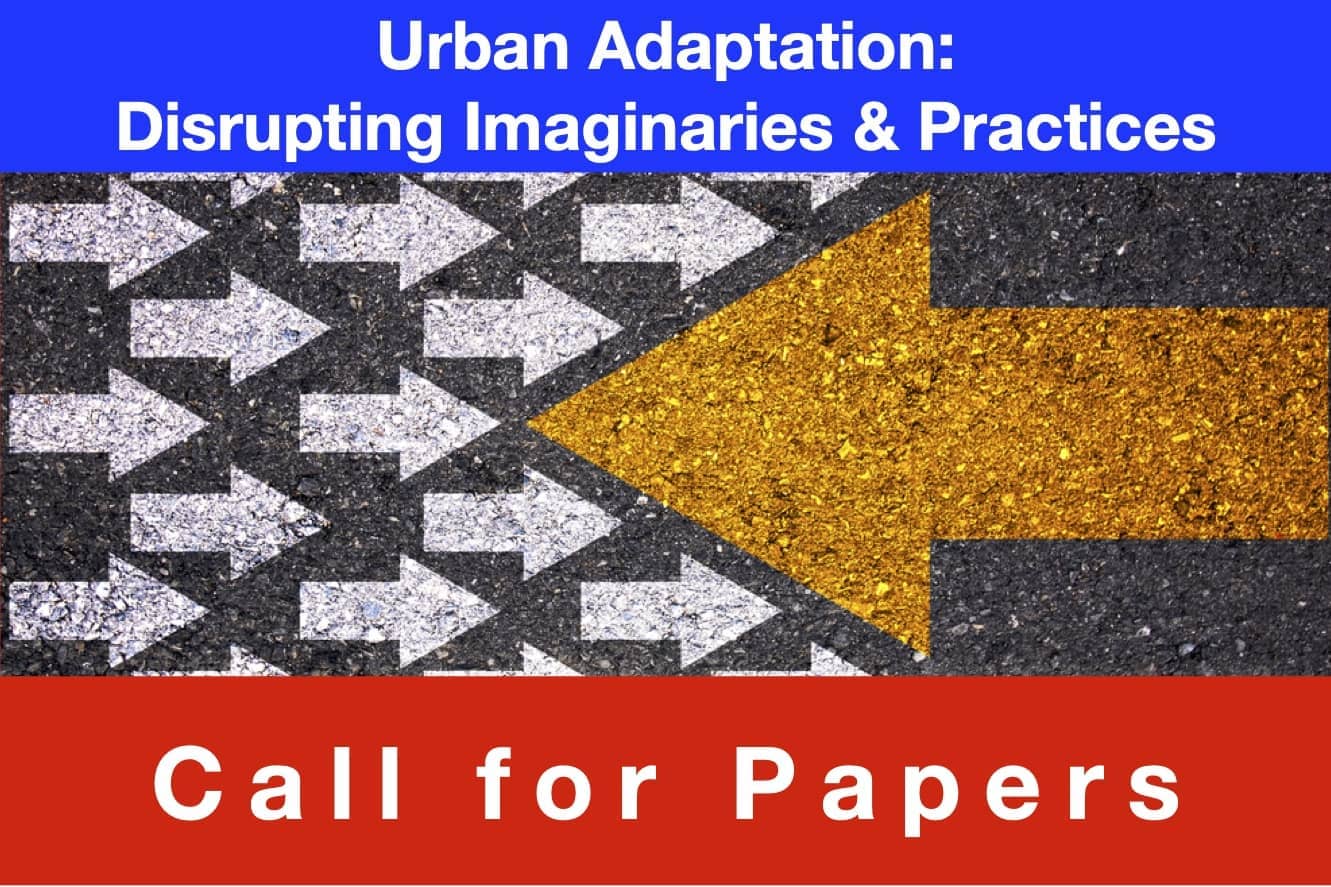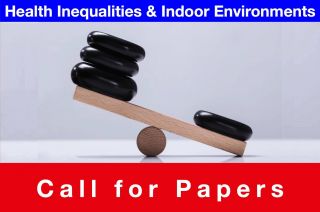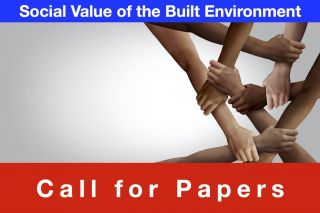
www.buildingsandcities.org/calls-for-papers/urban-adaptation-disrupting-imaginaries.html
Urban Adaptation: Disrupting Imaginaries & Practices

Guest Editors: Vanesa Castán Broto (U of Sheffield), Marta Olazabal (Basque Centre for Climate Change), Gina Ziervogel (U of Cape Town)
Abstract submission closed on 3 MAY 2023
Now more than ever, cities and urban areas are confronted with the urgency of climate change adaptation: increases in temperatures and heatwaves, water and food scarcity, flash floods and sea-level rise, among other impacts.
This special issue aims to enlarge the range of adaptation narratives grounded in experiences from cities worldwide, seeks a more pluralistic, inclusive approach to urban adaptation, and explores ways to identify and disrupt ill-suited approaches.
Aims
The assumption is that current imaginaries (ways to understand and envisage how adaptation should take place) and practices need to be revised to provide social justice and reflect local needs. The special issue focuses on how inappropriate / inadequate urban adaptation imaginaries and practices can be identified and disrupted to provide more inclusive, socially just approaches to urban adaptation. In the current context, urban adaptation action (in physical, social, political, legal dimensions) is needed to break with the status quo, reduce systemic vulnerabilities and increase coping capacities (resilience) to face climate change impacts at scale (Pelling et al. 2015). What examples, methodologies and understandings challenge the received knowledge and practices in urban adaptation and be used to inform and generate more creative, inclusive adaptation responses?
Background / context
'Building and Cities' pioneered the question of social justice when considering adaptation in the built environment (Klinsky & Mavrogianni 2020). Urban adaptation is an urgent need: even if current efforts were to halt emissions, global average temperatures have already changed enough to demand adaptive responses from human societies (Pörtner et al. 2022). However, urban adaptation responses remain inadequate. Even when adaptation actions exist, they tend to secure some groups of people and tracks of land at the expense of others, thus leading to maladaptation (Magnan et al. 2016). Empirical evidence shows that many forms of adaptation emerge from below and from within everyday experiences (bottom-up approaches), but these are seldom recognised in adaptation plans (Olazabal et al. 2021).
Part of the challenge relates to the overall reliance on dominant adaptation imaginaries that reproduce technocratic accounts of adaptation action (Eriksen et al. 2021). Adaptation strategies and interventions continue to be transferred as best practices from one city to another or applied under assumed equal conditions across different parts of the same city. Often these imaginaries are based upon pioneering experiences of large, rich cities in industrialised countries which hardly engage with the adaptation realities in cities around the world, particularly in the Global South. There is a wide agreement that adaptation planning should be context-specific and dependent on existing institutional and material constraints, resources, and social and political commitment. However, policy and planning practices, grounded on existing scholarly debates, approach adaptation planning as linear processes that can be replicated widely.
In contrast, local adaptation practices often depend on disruptive local processes that sometimes only emerge during the process and are not initially identified. For example, practice reveals that urban adaptation can also happen through incremental change, data-poor environments or autonomous initiatives that deliver resilience. Likewise, practice has identified the need to harness existing capacities to deliver adaptation as collective action rather than as a top-down imposition. There is also a need for capacities that are deemed to be transformative, especially capacities for social learning to assess adaptation outcomes and enable social change. This may require disrupting existing adaptation imaginaries and developing a wider range of adaptation actions that encompasses large-scale, institutional efforts alongside a wide range of local, networked initiatives.
Climate Resilient Development Pathways (CRDPs) (Singh & Chudasama 2021) refer to the range of enabling conditions that provide continued opportunities to deliver adaptation action, aligning adaptation goals with the objectives marked in the Sustainable Development Goals (SDGs) and local urban development goals. Moving from ad hoc, single, project-based methods to a systemic, multi-actor, an integral response may be a means to deliver CRDPs. However, disrupting adaptation imaginaries may entail not thinking of adaptation as an additive condition but instead focusing on more just environments that work for everyone's well-being (Eriksen et al. 2021). New debates on intersectional adaptation, co-production, decolonisation and epistemic injustices are likely to play a key role in disrupting adaptation debates (Amorim-Maya et al. 2021). CRDPs call for new imaginaries of adaptation that move beyond existing knowledge.
The IPCC Working Group II (Impacts, Vulnerability and Adaptation) contribution to the 6th Assessment Report in February 2022 (Pörtner et al. 2022) marked a significant departure from the previous one in 2014 in establishing a direct link between adaptation possibilities, drivers of vulnerability and urbanization and foregrounding governance and justice issues. It further aligns adaptation objectives with broader development objectives as outlined in the UN's 2030 Development Agenda and SDGs, thus supporting CRDPs. The latest IPCC report is, most of all, 'a solutions report' that emphasises what can be done and who can do it. Chapter 6 'Cities, Settlements and Key Infrastructure' considers three areas where solutions could be prioritised:
- infrastructure management, especially the increasing interconnections between different networks and digitalization
- the unique role that green and blue urban areas play in facilitating adaptation (e.g. nature-based solutions)
- social infrastructures (from social support policies to health and education systems) are central to supporting the most vulnerable groups.
None of these solutions will be effective in isolation without considering the enabling context in which they will be implemented. Understanding the trade-offs between adaptation and mitigation responses and the necessary integration across impacts, adaptation and resilience is essential in urban environments.
Suggested topics
This special issue will contribute directly to current debates on Climate Resilient Development Pathways (CRDPs) (Singh & Chudasama 2021). Examples of adaptation are sought that question established theories or assumptions about what urban adaptation is and how to evaluate success, progress or effectiveness in (transformative) adaptation. Adaptation is often understood as either being top-down or bottom-up (Butler et al. 2015), but middle-out possibilities (mixed approaches, privately-led or intermediary actors) also exist. Contributions on top-down, bottom-up and all kinds of hybrid formulations of adaptation (Butler et al. 2015) are sought to disrupt dominant imaginaries and draw alternatives that seek to broaden the adaptation solution space through transformative approaches and outcomes. Most exercises on adaptation imaginaries and visioning are about what will happen and what could happen (Nalau & Cobb 2022). We seek responses that allow more transformative and inclusive thinking and disrupt current urban adaptation imaginaries and practices. Examples are sought that talk about the diversity of adaptation approaches and are open to both positive and negative outcomes, recognising that maladaptation does not need to be the outcome of adaptation action.
Potential topics include but are not limited to:
- Analysing the wide range of actors
that intervene in urban adaptation at different scales of action: international,
national, local government, neighbourhood
a) WHO should do adaptation? WHO has / does not have a voice? WHO has efficacy and/or power?)
b) The roles and influence of international finance and political capital in urban adaptation, especially in the Global South - Analysing HOW urban adaptation occurs at different spatial and temporal scales. HOW and WHEN does change occur?
- Questioning dominant thinking on WHAT
urban adaptation is possible and desirable:
a) New understandings of resilient infrastructure and analysis of infrastructure interdependencies that may condition adaptation
b) The role of green and blue infrastructures to build resilience in the built environment
c) Analyses that recognise the wide range of social infrastructures that support adaptation
d) Constraints and opportunities at different scales due to social, political and legal frameworks
e) Processes for identifying and evaluating which existing adaptation imaginaries / aspects work well or need disruption - Unpacking the notion of CRDPs in
relation to place-based adaptation
a) Analyses of trade-offs between mitigation, adaptation and broader SDGs especially transformative change and justice issues
b) Reflecting on WHEN and WHERE urban adaptation is possible and desirable, aligning it with the concept of CRDP
c) Long-term thinking, integrated approaches and learning on how to manage changing conditions and changing socio-ecological and technological contexts - Explaining or challenging the meaning of transformative urban adaptation & key emerging words and concepts e.g. 'intersectional,' 'inclusive,' 'decolonial', 'gender equality'
- What are the different advantages and contradictions of bottom-up, top-down and middle-out approaches?
- Developing alternative framings of governance processes (insurance, finance, law) that support disruptive urban adaptation
- Methodologies to disrupt urban adaptation imaginaries
Briefing note for contributors
You are invited to submit an abstract for this special issue. Please send a 500 word (maximum) abstract to editor Richard Lorch richard@rlorch.net by 3 May 2023. Your submission must also include these 3 items:
- the author's and all co-author's names, institutional & departmental affiliations and contact details
- the specific question(s) in this Call for Papers that the abstract and intended paper address
- the abstract (500 words maximum) defining the research question(s), scope, methods and (expected) results
Abstracts will be reviewed by the editors to ensure a varied, yet integrated selection of papers around the topic. Authors of accepted abstracts will be invited to submit a full paper (6000-7500 words), which undergoes a double-blind review process.
Open access
Buildings & Cities is an open access journal and has an article processing charge (APC) of £1200. If you do not have institutional support, please notify the editor when submitting your abstract. B&C endeavours to assist those without funding.
Buildings & Cities
Buildings & Cities is an international, open-access, double-blind peer-reviewed research journal. Its focus is the interactions between buildings, neighbourhoods and cities by understanding their supporting social, economic and environmental systems. More information can be found online: www.buildingsandcities.org & published papers are found here: https://journal-buildingscities.org
Questions?
If you have a question, please contact: Richard Lorch Vanesa Castán Broto Marta Olazabal or Gina Ziervogel
Timeline
| Deadline for abstract submission | 3 May 2023 | |
| Full papers due | 11 September 2023 | NB: authors can submit full papers sooner if they wish |
| Referees' comments & decision to authors | 11 December 2023 | |
| Revised papers due | 2 February 2024 | |
| Publication | May 2024 | NB: papers are published as soon as they are accepted |
References
Amorim-Maia, A.T., Anguelovski, I., Chu, E. & Connolly, J. (2022). Intersectional climate justice: A conceptual pathway for bridging adaptation planning, transformative action, and social equity. Urban climate, 41, 101053.
Butler, J.R.A., Wise, R.M., Skewes, T.D., Bohensky, E.L., Peterson, N., Suadnya, W., Yanuartati, Y., Handayani, T., Habibi, P., Puspadi, K. & Bou, N. (2015). Integrating top-down and bottom-up adaptation planning to build adaptive capacity: a structured learning approach. Coastal Management, 43(4), 346-364.
Eriksen, S., Schipper, E.L.F., Scoville-Simonds, M., Vincent, K., Adam, H.N., Brooks, N., Harding, B., Lenaerts, L., Liverman, D., Mills-Novoa, M. & Mosberg, M. (2021). Adaptation interventions and their effect on vulnerability in developing countries: Help, hindrance or irrelevance?. World Development, 141, 105383.
Klinsky, S. & Mavrogianni, A. (2020). Climate justice and the built environment. Buildings and Cities, 1(1), 412-428.
Magnan, A.K., Schipper, E.L.F., Burkett, M., Bharwani, S., Burton, I., Eriksen, S., Gemenne, F., Schaar, J. & Ziervogel, G. (2016). Addressing the risk of maladaptation to climate change. Wiley Interdisciplinary Reviews: Climate Change, 7(5), .646-665.
Nalau, J., & Cobb, G. (2022). The strengths and weaknesses of future visioning approaches for climate change adaptation: A review. Global Environmental Change, 74, 102527.
Olazabal, M., Chu, E., Castan Broto, V.C. & Patterson, J. (2021). Subaltern forms of knowledge are required to boost local adaptation. One Earth, 4(6), 828-838.
Pelling, M., O'Brien, K. & Matyas, D. (2015). Adaptation and transformation. Climatic Change, 133(1), 113-127.
Pörtner, H.O., Roberts, D.C., Adams, H., Adler, C., Aldunce, P., Ali, E., Begum, R.A., Betts, R., Kerr, R.B., Biesbroek, R. & Birkmann, J. (2022). Climate change 2022: Impacts, adaptation and vulnerability. IPCC Sixth Assessment Report, pp.37-118.
Singh, P.K. & Chudasama, H. (2021). Pathways for climate resilient development: Human well-being within a safe and just space in the 21st century. Global Environmental Change, 68, 102277.
Latest Peer-Reviewed Journal Content
A framework for 1.5°C-aligned GHG budgets in architecture
G Betti, I Spaar, D Bachmann, A Jerosch-Herold, E Kühner, R Yang, K Avhad & S Sinning
Net zero retrofit of the building stock [editorial]
D Godoy-Shimizu & P Steadman
Co-learning in living labs: nurturing civic agency and resilience
A Belfield
The importance of multi-roles and code-switching in living labs
H Noller & A Tarik
Researchers’ shifting roles in living labs for knowledge co-production
C-C Dobre & G Faldi
Increasing civic resilience in urban living labs: city authorities’ roles
E Alatalo, M Laine & M Kyrönviita
Co-curation as civic practice in community engagement
Z Li, M Sunikka-Blank, R Purohit & F Samuel
Preserving buildings: emission reductions from circular economy strategies in Austria
N Alaux, V Kulmer, J Vogel & A Passer
Urban living labs: relationality between institutions and local circularity
P Palo, M Adelfio, J Lundin & E Brandão
Living labs: epistemic modelling, temporariness and land value
J Clossick, T Khonsari & U Steven
Co-creating interventions to prevent mosquito-borne disease transmission in hospitals
O Sloan Wood, E Lupenza, D M Agnello, J B Knudsen, M Msellem, K L Schiøler & F Saleh
Circularity at the neighbourhood scale: co-creative living lab lessons
J Honsa, A Versele, T Van de Kerckhove & C Piccardo
Positive energy districts and energy communities: how living labs create value
E Malakhatka, O Shafqat, A Sandoff & L Thuvander
Built environment governance and professionalism: the end of laissez-faire (again)
S Foxell
Co-creating justice in housing energy transitions through energy living labs
D Ricci, C Leiwakabessy, S van Wieringen, P de Koning & T Konstantinou
HVAC characterisation of existing Canadian buildings for decarbonisation retrofit identification
J Adebisi & J J McArthur
Simulation and the building performance gap [editorial]
M Donn
Developing criteria for effective building-sector commitments in nationally determined contributions
P Graham, K McFarlane & M Taheri
Reimagining circularity: actions for optimising the use of existing buildings
R Lundgren, R Kyrö, S Toivonen & L Tähtinen
Effective interdisciplinary stakeholder engagement in net zero building design
S Vakeva-Baird, F Tahmasebi, JJ Williams & D Mumovic
Metrics for building component disassembly potential: a practical framework
H Järvelä, A Lehto, T Pirilä & M Kuittinen
The unfitness of dwellings: why spatial and conceptual boundaries matter
E Nisonen, D Milián Bernal & S Pelsmakers
Environmental variables and air quality: implications for planning and public health
H Itzhak-Ben-Shalom, T Saroglou, V Multanen, A Vanunu, A Karnieli, D Katoshevski, N Davidovitch & I A Meir
Exploring diverse drivers behind hybrid heating solutions
S Kilpeläinen, S Pelsmakers, R Castaño-Rosa & M-S Miettinen
Urban rooms and the expanded ecology of urban living labs
E Akbil & C Butterworth
Living with extreme heat: perceptions and experiences
L King & C Demski
A systemic decision-making model for energy retrofits
C Schünemann, M Dshemuchadse & S Scherbaum
Modelling site-specific outdoor temperature for buildings in urban environments
K Cebrat, J Narożny, M Baborska-Narożny & M Smektała
Understanding shading through home-use experience, measurement and modelling
M Baborska-Narożny, K Bandurski, & M Grudzińska
Building performance simulation for sensemaking in architectural pedagogy
M Bohm
Beyond the building: governance challenges in social housing retrofit
H Charles
Heat stress in social housing districts: tree cover–built form interaction
C Lopez-Ordoñez, E Garcia-Nevado, H Coch & M Morganti
An observational analysis of shade-related pedestrian activity
M Levenson, D Pearlmutter & O Aleksandrowicz
Learning to sail a building: a people-first approach to retrofit
B Bordass, R Pender, K Steele & A Graham
Market transformations: gas conversion as a blueprint for net zero retrofit
A Gillich
Resistance against zero-emission neighbourhood infrastructuring: key lessons from Norway
T Berker & R Woods
Megatrends and weak signals shaping future real estate
S Toivonen
A strategic niche management framework to scale deep energy retrofits
T H King & M Jemtrud
Generative AI: reconfiguring supervision and doctoral research
P Boyd & D Harding
Exploring interactions between shading and view using visual difference prediction
S Wasilewski & M Andersen
How urban green infrastructure contributes to carbon neutrality [briefing note]
R Hautamäki, L Kulmala, M Ariluoma & L Järvi
Implementing and operating net zero buildings in South Africa
R Terblanche, C May & J Steward
Quantifying inter-dwelling air exchanges during fan pressurisation tests
D Glew, F Thomas, D Miles-Shenton & J Parker
Western Asian and Northern African residential building stocks: archetype analysis
S Akin, A Eghbali, C Nwagwu & E Hertwich
Join Our Community

The most important part of any journal is our people – readers, authors, reviewers, editorial board members and editors. You are cordially invited to join our community by joining our mailing list. We send out occasional emails about the journal – calls for papers, special issues, events and more.
We will not share your email with third parties. Read more



Latest Commentaries
COP30 Report
Matti Kuittinen (Aalto University) reflects on his experience of attending the 2025 UN Conference of the Parties in Belém, Brazil. The roadmaps and commitments failed to deliver the objectives of the 2025 Paris Agreement. However, 2 countries - Japan and Senegal - announced they are creating roadmaps to decarbonise their buildings. An international group of government ministers put housing on the agenda - specifying the need for reduced carbon and energy use along with affordability, quality and climate resilience.
Building-Related Research: New Context, New Challenges
Raymond J. Cole (University of British Columbia) reflects on the key challenges raised in the 34 commissioned essays for Buildings & Cities 5th anniversary. Not only are key research issues identified, but the consequences of changing contexts for conducting research and tailoring its influence on society are highlighted as key areas of action.